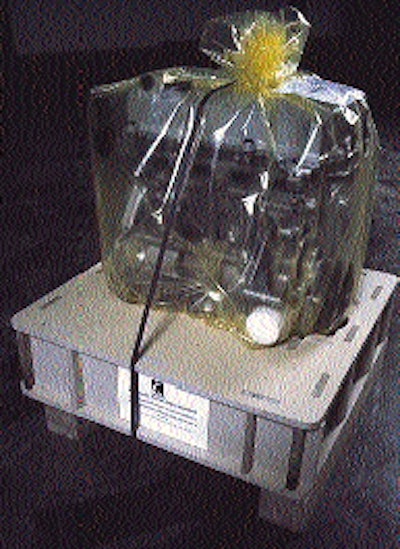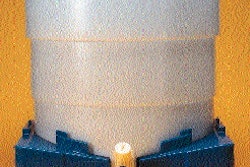Saturn Service Parts Operation has a reputation for being unusually creative, from design through car assembly to the retailer showroom. This attitude of breaking the auto industry mold also extends to parts packaging, as a recent project for replacement engines demonstrates. Until last year, Saturn shipped replacement engines from its Spring Hill, TN, plant to retailers on a specially sized wooden pallet topped with a wooden cradle to hold and protect the motor. This is the typical transport container most manufacturers use to safely and securely ship the heavy, costly and vulnerable motors from factory to retailer service departments. In '94, Saturn began to use a new engine pallet designed by Homasote Co. (West Trenton, NJ). It's made of the company's Pak-Line® material, which consists of recycled newsprint and other paper. Not only does the use of Pak-Line make environmental sense for Saturn, but the new pallets have several other features: * The new pallets save Saturn up to 40% of the cost of the former wooden pallet/cradle combinations. * At Spring Hill, the pallets have a low profile for easy stacking; the former wooden parts couldn't be stacked at all. * Because the design permits the engine to nestle lower to the ground, the center of gravity is lower so they're easier to move and less likely to be damaged. * The space-saving design allows the easy return of the pallet to the plant for reuse. This not only cuts costs at the plant, it also saves the retailers from having to pay for disposal of the former wooden pallet/cradles. One size fits both Saturn has two different engines for its cars--single and double overhead camshaft models--and the engine pallet was designed to fit both. The differences between the two are all on the upper half of the engine. The bottom of the engine, specifically the oil pan, fits into the cavity created by the die-cut top piece of the pallet and rests on the cross braces. "Although this pallet is much lighter in weight than the wooden version we used before, we think it's actually better in terms of engine protection," says packaging engineer Ken Teran of Saturn's Service Parts Operation. "The center of gravity is lower so it's less likely to be tipped over, and it's easier to move." This is helpful even at Spring Hill. The Power Train Team first wraps a plastic bag around the engine and then inserts it into the pallet and straps it. It's transferred to the parts department and inventoried until it's ready to ship. The corrugated cover is put in place and the box is labeled for the correct customer. Unlike the previous wooden pallet/cradle, the new engine pallet can be returned inside one of the rolling cages that are used to transport parts between Spring Hill and individual retailers. These cages are used with what the automotive industry calls a "dedicated transport system." Saturn gets between five and ten trips from each pallet, Teran says, "far more trips than we expected. Some-times you get oil drippage from returned used engines on a pallet but it doesn't affect the pallet's later performance." They're also an ergonomic plus because of their lighter weight and stackability. Just in time The new pallet really responds to the plant's operating philosophy. To help reduce the number of its suppliers, Saturn orders the Pak-Line pieces from Homasote through its corrugated supplier, Stone Container (Chicago, IL). A nearby Stone plant inventories the pieces until the Saturn plant places an order. For this application, the Saturn pallet is fabricated from a medium-density, 5/8"-thick board, a 440 Pak-Line. It accepts the 220-lb-plus engine without difficulty; this board is rated to support up to 6ꯠ lb, says Homasote's Carl Good. Saturn did rigorous testing to ensure the stability of the paper material. Homasote manufactures the sheet almost exclusively from old newspapers that are hydropulped and treated with a very small amount of paraffin to provide weather resistance. The fiber mix is conveyed into large forming molds that shape and then press the product to the right thickness before drying and cutting to the appropriate lengths. Final cutting is then done to order. Stone delivers the Pak-Line pieces to a local supplier where the pieces are assembled. The top and bottom deck boards and the interior and exterior supports are all made to fit together without hardware. Only the bottom stringers are attached with screws. Depending on the plant's needs, the workshop delivers the finished pallets as often as daily so the plant rarely has to stock the pallets. When the change was made, the new pallet design saved the plant nearly 40%.


























